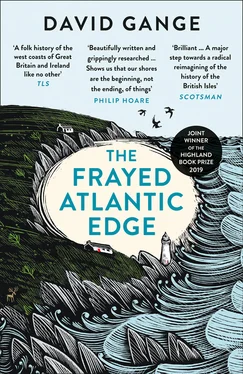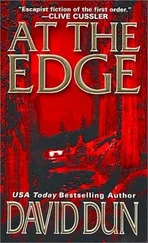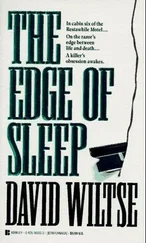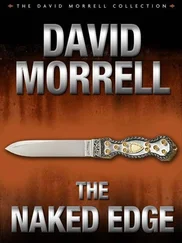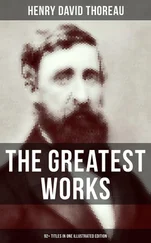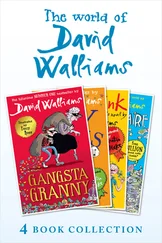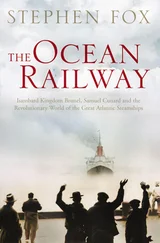I began by kayaking north-east. The small island of Papa Westray, known locally as Papay, thrusts a rugged and disruptive head north of Westray and into the Atlantic’s flow. As I paddled into the mile-wide sound between islands I found myself grinning with pleasure to be back among the waves. I’d missed the ocean’s noise, the tension in the arms as they pull a paddle through water, and, most of all, the sense of unrooting that rocking over waves creates. I kayaked carelessly, enlivened by cold splashes from the bow and paddle. Yet before I’d even really got started, I felt the lure of Papay’s past.
This island proved to be the most improbable place I’ve visited. Its history emerges from waves and grasses in ways that feel surreal. Sometimes traces of the past are recent and mundane but still evocative of island life. My route reached the island at a pretty place where low cliffs are topped with a small, strangely situated structure that is blackened by burning. It stands on its isolated outcrop because this picturesque inlet faces directly into south-westerly wind and swell. For decades the vulnerability of this spot made it the ideal rubbish dump. Litter on the scale of cars and sofas would be thrown down the rocks and carried away by winter storms that were more muscular and reliable than any binmen. Local lobsters still dwell, perhaps, in the rusted boots and bonnets of Ford Cortinas.
As I rounded the island, the surprises became more venerable. I passed an enormous kelp store, a remnant of the decades round 1800 when Papay was a global centre of this major industry. Paddling past, and beneath one of the most spectacular chambered cairns in the world, I landed on a sandy beach beside a small and unassuming isthmus of stones and seaweed. I’d intended to wander up the cliffs and visit a monument to the extinction of an Atlantic seabird. But the spot I’d landed at was not what it seemed. At first, I thought I was hallucinating as I saw patterns in rocks where seaweed was strewn like tea leaves. But the more I stared, the clearer the geometry became: a cobbled platform took shape, then hints at a low stone wall. These sea-smoothed structures were centuries older than the era of kelp but, for now, the nature of their making remained a mystery.
I wandered up the cliffs to find the monument I’d stopped for. In 1813, ‘King Auk’ was the last great auk in Britain. These birds – penguin-sized relatives of the razorbill – were once prized for feathers, meat and eggs, but by the early nineteenth century the collection of stuffed birds had become a favourite pastime of Europe’s elite. What could possibly cement a wealthy collector’s status like the large, impressive corpse of ‘the rarest bird in the world’? There are many discrepancies in narrations of the events of 1813, but it seems that ‘local lads’ had killed King Auk’s mate by stoning the previous year. Now William Bullock, impresario and keeper of the Egyptian Hall in Piccadilly, had written to the lairds of Papay requesting the very last bird for his collection. The obliging lairds tasked six local men to row to the third cave along the north Papay crags. King Auk leapt from his perch into the sea and a marksman, Will Foulis, fired and fired again. But the auk was agile in the water. Eventually cornered, King Auk was bludgeoned to death with oars. The bloodied prize was soon in the hands of couriers to London where it became a feature of Bullock’s ever more elaborate displays, to which another one-off, Napoleon’s carriage from Waterloo, was later added.
The cairn I visited on the cliffs above King Auk’s perch was put in place by local children. Concealed in the memorial, beneath a bright red sculpture of the royal bird, is a time capsule containing the message they wrote to the future:
We wish there was still a great auk to see. We hope that people won’t have to build more cairns like this to remember things we see alive now. We humans gave a name to this bird, now only the name is left. If you who are reading this message are not human, remember us with kindness as we remember the great auk. 1
The fate of King Auk marks Papay as a place of endings. But after I’d battled round the island’s violent northern headland, I reached sites that spoke instead of beginnings. The most famous is the Knap of Howar. This is the earliest known constructed house in Europe. Built as a family farm around 5700 BC the land its occupants tilled and grazed has been eaten away by water until the Knap is nestled in reach of sea spray. Its concave walls and intricate cupboard-like enclaves are missing only soft furnishings and whale-rib rafters. Rabbits burrow all round. As they dig, they disinter refuse from ancient human meals: worn oyster shells, and great-auk bones, whose flesh was stripped millennia ago. Like so many sea-lapped sites, the Knap of Howar inspires conflicting responses. Thoughts are easily lured towards ideas of timelessness, yet everything about this site has been transformed: the quality of its earth and the nature of its foliage have been slowly altered by the creeping proximity of ocean. If timelessness exists anywhere on earth, it is not in sight of the sea.
Even the Knap of Howar is not the most immediate and affecting spot here. A little to the north, St Boniface’s Kirk stands on the site of older holy places. Northerly gales flay earth from every inch of coast, changing topography by the week. Grasses and wildflowers cling to steep sandy soils where summer respite from storms provides the fleeting chance of growth before roots are ripped away and flung into autumn. It’s easy to sit and stare into the ocean without comprehending the structures of rock and shell around you. From every inch of land the ocean takes, there appears a new facet of a large medieval settlement. 2I’d glanced around layer upon layer of exposed walls and floors before I began to notice the refuse beneath them: thousands of shells of limpet, oyster and winkle clustered where they’d been littered after feasts. Storms here have disinterred whale vertebrae, from even grander feasting, and red quernstones for grinding grain, made of rock not native to the island. Remnants of the processing of pig iron and fish oil imply a community that worked the coast in sophisticated ways.
There’s something evocative about the daily changes occurring at this unmarked, uncelebrated site. The configuration of buildings and shells seen on any visit is immediately taken by the ocean, never to be witnessed again nor recorded. It’s impossible to categorise such places. Most of this island fits both poles of many binaries depending on the light you choose to see it in: human/wild, timeless/changing, productive/barren. Everything seems both out of place and perfectly positioned, and our frameworks for comprehending the coastal past feel entirely inadequate.
Unable to imagine what it must be like to live in a landscape so immediate but so inscrutable, I knew I needed help. Before setting out I’d contacted Papay’s ‘biographer’, Jim Hewitson. Jim told me he and his wife Morag intended to travel no further than the Old Pier, 500 metres from their home, for the rest of the year: when I passed, he said, I’d find them at home or in a nearby field. In the early afternoon, I knocked on the Hewitsons’ door and was led into an old schoolhouse. On one wall was a large map marked with Papay’s historic place names. Elsewhere were images from the island’s past including a painting of King Auk. This was pinned beside a memorial to a French kayaker who visited when paddling north. He’d planned his journey with his wife before her untimely death. Having undertaken the voyage alone, he disappeared, presumed drowned, before reaching Shetland; I didn’t dare ask whether he and I were the only kayakers to have visited the Hewitsons.
I sat with Morag and Jim, consuming tales of island life along with tea and croissants. Then we wandered the coast. I was soon told, in no uncertain terms, that my desire to find explanations of the coast’s mysteries was not an acceptable approach to the island. Life on Papay, they insisted, involves coming to terms with mystery, not seeing it as a problem to conquer. Jim and I revisited the strange cobbled structures of the beach I’d landed on. He told me that archaeologists call it a medieval fish farm, used by monks from a monastery that may or may not have existed when Papay might or might not have been the centre of an eighth-century bishopric founded by Iona monks (or someone else). Yet Jim and Morag’s children have found antlers in this ‘fish farm’; perhaps this was actually a spot for trapping deer whose movements would be impeded in the soft coastal ground. I was left wondering about the boundaries of ‘mystery’. Without Morag and Jim’s help it would have been impossible for me to write about the island at all. Before our conversations I had answers to bad questions; I was left with much better questions but no hope of answers. And I’d been given a reminder that archaeology is rarely about discovering or confirming facts, but more often a process of inventing the most plausible possible stories.
Читать дальше
